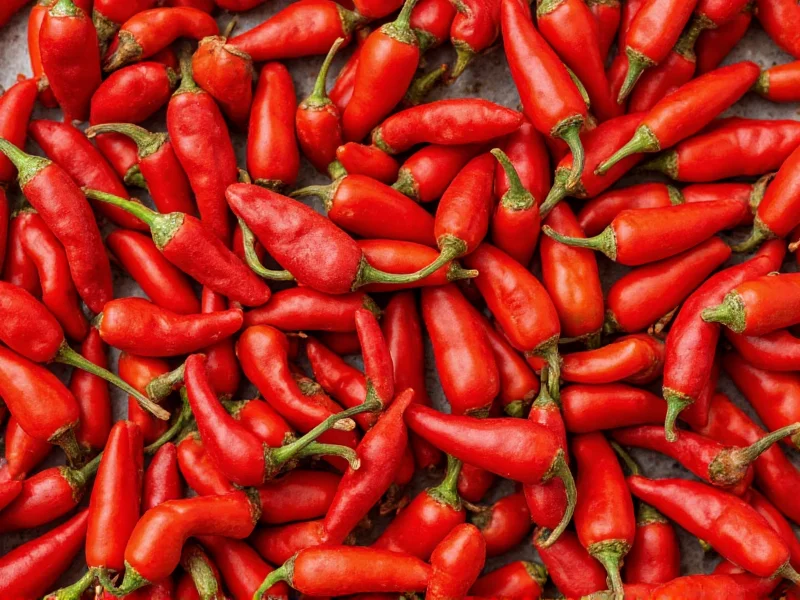When exploring is cayenne pepper similar to paprika, many home cooks assume these red spices are interchangeable. Understanding their distinct characteristics prevents recipe disasters and enhances your culinary precision. Let's examine these common pantry staples in detail.
Botanical Origins and Processing
Both spices derive from dried and ground peppers in the Capsicum annuum species, but different cultivars create distinct end products. Cayenne pepper comes specifically from elongated, tapered cayenne peppers known for their fiery heat. Paprika encompasses a broader category made from various sweet and hot peppers, primarily bell peppers and less pungent chili varieties.
The processing methods further differentiate them. Authentic Hungarian paprika undergoes careful smoking or drying techniques that develop its characteristic earthy-sweet profile. Cayenne maintains its straightforward drying process that preserves maximum capsaicin—the compound responsible for heat.
Heat Comparison: Understanding the Scoville Scale
When considering can I substitute paprika for cayenne pepper, heat level is the critical factor. The Scoville scale quantifies this difference:
| Spice Type | Scoville Heat Units | Relative Heat Level |
|---|---|---|
| Cayenne Pepper | 30,000-50,000 SHU | Very Hot |
| Hot Paprika | 5,000-10,000 SHU | Moderately Spicy |
| Sweet Paprika | 0-500 SHU | Mild/Sweet |
| Smoked Paprika | 100-2,000 SHU | Mild with Smoky Notes |
This substantial heat difference explains why substituting one for the other without adjustment often leads to underwhelming or overwhelmingly spicy results. A single teaspoon of cayenne contains approximately 15-20 times more heat than the same amount of sweet paprika.
Flavor Profiles and Culinary Applications
Examining what's the difference between cayenne and paprika reveals distinct flavor characteristics:
- Cayenne pepper delivers a sharp, immediate heat with minimal flavor complexity beyond its burning sensation. Chefs use it primarily for heat adjustment in sauces, stews, and spice blends.
- Sweet paprika offers earthy, slightly sweet notes with pepper undertones and zero heat. It's essential in Hungarian goulash, Spanish chorizo, and as a colorful garnish.
- Smoked paprika (pimentón) provides deep smoky complexity from peppers dried over oak fires. This variety features prominently in Spanish cuisine and adds dimension to rubs and marinades.
- Hot paprika bridges the gap with moderate heat plus the characteristic paprika flavor, commonly used in Eastern European dishes.
Substitution Guidelines: When and How to Swap
Understanding paprika vs cayenne pepper substitution prevents culinary mishaps. Consider these practical guidelines:
If your recipe calls for cayenne but you only have paprika, you'll need to adjust significantly. For every ¼ teaspoon of cayenne, use 1½ to 2 teaspoons of hot paprika. Sweet paprika won't provide adequate heat replacement—consider adding a pinch of cayenne to sweet paprika for closer approximation.
Conversely, when substituting paprika for cayenne, remember that sweet paprika provides color without heat. For recipes requiring both color and moderate heat, combine sweet paprika with a small amount of cayenne (start with 1 teaspoon paprika plus ⅛ teaspoon cayenne).
Color Contributions in Cooking
Both spices contribute vibrant red hues, but with different visual effects. Cayenne produces a deeper, more orange-tinged red, while paprika—especially Hungarian varieties—delivers a brighter, more intense red color. This distinction matters in dishes where appearance is crucial, such as deviled eggs or seafood boils.
Chefs often use paprika as a finishing touch for its superior color properties, while cayenne gets incorporated during cooking to distribute its heat evenly. The misconception that these spices are identical likely stems from their similar appearance in spice jars, despite their different culinary behaviors.
Storage and Shelf Life Considerations
Both spices lose potency over time but at different rates. Cayenne maintains its heat longer than paprika retains its flavor complexity. For optimal results, replace cayenne every 2-3 years and paprika annually. Store both in airtight containers away from light and heat to preserve their distinctive characteristics.
Common Misconceptions Clarified
Many believe is cayenne pepper similar to paprika enough to use interchangeably without consequences. This misunderstanding leads to inconsistent results. While both are red pepper derivatives, their heat levels and flavor profiles serve different culinary purposes.
Another misconception involves smoked paprika. Some assume it's merely a spicier version of regular paprika, but the smoking process creates entirely different flavor compounds unrelated to heat intensity. Understanding difference between cayenne pepper and smoked paprika helps prevent flavor imbalances in dishes requiring specific profiles.











 浙公网安备
33010002000092号
浙公网安备
33010002000092号 浙B2-20120091-4
浙B2-20120091-4